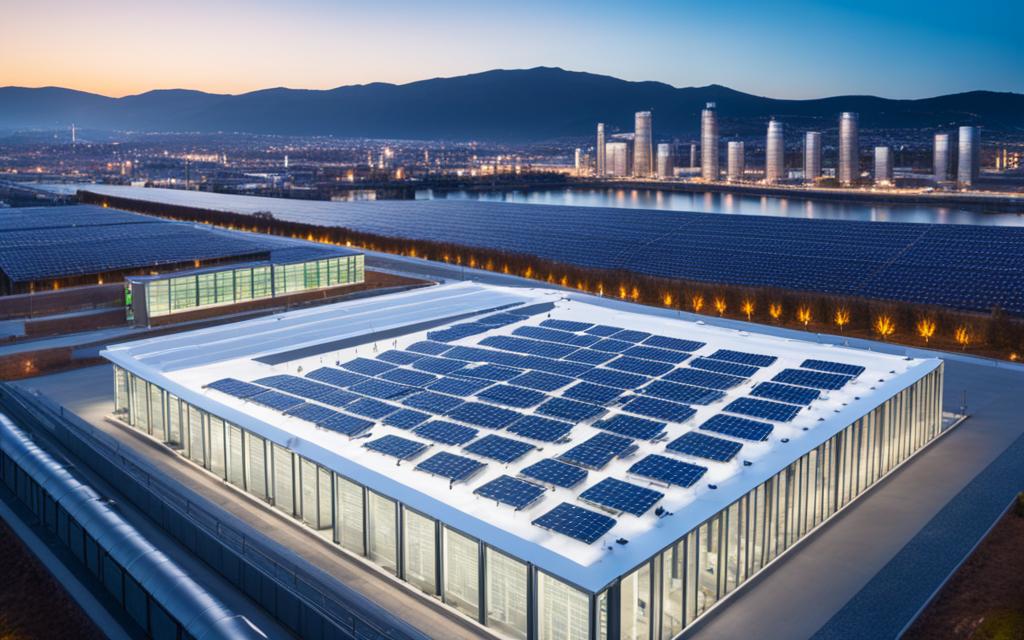Revolutionizing Power Distribution And Upgrading Existing Systems

The power distribution industry is undergoing a transformative shift with the integration of smart technologies.
Leading switch manufacturers are revolutionizing power distribution systems, upgrading existing infrastructure, and improving efficiency.
This will explore the transformative impact of advanced switch technologies on the power sector and how they elevate infrastructure efficiency across the US.
Key Takeaways
- Advanced switch technologies play a crucial role in optimizing power distribution infrastructure.
- These technologies offer real-time monitoring, remote control, and predictive maintenance capabilities.
- Integrating IoT, sensor technology, and predictive analytics is driving the development of advanced switch technologies.
- Advanced switch technologies improve reliability, system performance, energy distribution, and maintenance costs.
- They find applications in commercial buildings, industrial facilities, data centers, and renewable energy systems.
The Importance Of Advanced Switch Technologies
Advanced switch technologies are paramount when it comes to optimizing power distribution infrastructure.
These innovative solutions are crucial in ensuring a reliable power supply, enhancing system performance, and preventing costly downtime.
With their real-time monitoring, remote control, and predictive maintenance capabilities, advanced switch technologies significantly improve efficiency and elevate infrastructure efficiency.
Imagine being able to monitor and control your power distribution system in real-time from anywhere in the world.
Advanced switch technologies make this a reality, providing valuable insights into the system’s performance and health.
By constantly monitoring key parameters such as voltage, current, and temperature, these technologies enable proactive maintenance and timely intervention, reducing the risk of system failures and improving overall reliability.
“Advanced switch technologies offer advanced control and monitoring capabilities, allowing organizations to optimize power distribution and ensure uninterrupted operations.”
However, the benefits of advanced switch technologies extend beyond just reliability.
These technologies enable optimized energy distribution, ensuring power is delivered precisely where needed, resulting in improved efficiency and reduced energy waste.
With the ability to remotely control and manage switches, businesses can proactively adjust power distribution, responding to changing demands and maximizing energy efficiency.
Key Trends Shaping The Power Distribution Industry
The power distribution industry is witnessing significant transformation, driven by key trends shaping its future.
These trends, such as the integration of IoT and sensor technology, adoption of predictive analytics, the embrace of condition-based monitoring, and a heightened focus on cybersecurity, are revolutionizing the power distribution landscape.
As manufacturers adapt to these emerging trends, they develop advanced switch technologies that enhance infrastructure efficiency and drive industry growth.
Integrating IoT and sensor technology has emerged as a game-changer in the power distribution industry.
It enables the seamless flow of real-time data, allowing utilities and organizations to monitor power consumption, detect faults, and optimize energy distribution.
This data-driven approach enhances the overall efficiency of power distribution networks and reduces downtime.
Predictive analytics, another significant trend, utilizes advanced algorithms and machine learning techniques to anticipate and prevent power outages or equipment failure.
Predictive analytics enables proactive maintenance by analyzing historical data and optimizing the lifespan and performance of power distribution systems.
By addressing potential issues proactively, organizations can avoid costly downtime and ensure a reliable power supply.
The adoption of condition-based monitoring is also gaining momentum in the power distribution industry.
By continuously monitoring the health and performance of critical assets, such as transformers and switches, organizations can identify potential failures and plan maintenance activities accordingly.
Condition-based monitoring enhances asset reliability, reduces maintenance costs, and improves overall infrastructure efficiency.
The power distribution industry is also prioritizing cybersecurity to safeguard critical infrastructure from cyber threats. With the increasing connectivity of power distribution systems, protecting against unauthorized access, data breaches, and cyberattacks is crucial.
Manufacturers are implementing robust cybersecurity measures, including encryption protocols, access controls, and intrusion detection systems, to ensure the integrity and security of power distribution networks.
These key trends are shaping the future of the power distribution industry, driving the development of advanced switch technologies.
Manufacturers are investing in research and development to create intelligent and efficient switches that can seamlessly integrate with IoT devices, harness the power of predictive analytics, and withstand potential cyber threats.
As a result, infrastructure efficiency in power distribution continues to improve, enabling organizations to deliver reliable and affordable electricity to consumers.

As the power distribution industry evolves, manufacturers must stay ahead of trends and continue innovating.
By embracing these industry trends and developing cutting-edge switch technologies, manufacturers can contribute to the overall growth and sustainability of the power distribution sector.
Benefits Of Advanced Switch Technologies
Advanced switch technologies from leading manufacturers offer numerous benefits for power distribution systems.
By incorporating these innovative solutions, businesses can enhance their power infrastructure and improve efficiency.
Improved Reliability
One of the key benefits of advanced switch technologies is improved reliability.
These switches are designed to have higher fault tolerance, reducing the risk of power outages or disruptions.
With advanced features such as redundancy and intelligent monitoring, businesses can rely on a more stable power distribution system.
Enhanced System Performance
The integration of advanced switch technologies can greatly enhance system performance.
These switches are equipped with intelligent algorithms and predictive analytics, enabling businesses to optimize power distribution based on real-time data.
By efficiently managing energy flow and load balancing, businesses can maximize the performance of their power distribution systems.
Optimized Energy Distribution
Advanced switch technologies enable optimized energy distribution, leading to greater efficiency.
These switches can intelligently route power based on demand, ensuring that electricity is distributed to areas that need it the most.
With precise energy allocation, businesses can reduce energy wastage and improve overall energy utilization.
Reduced Maintenance Costs
Implementing advanced switch technologies can significantly reduce maintenance costs.
These switches have remote monitoring and control capabilities, allowing businesses to identify and address potential issues proactively.
By detecting faults early and performing preventative maintenance, businesses can avoid costly repairs and minimize downtime.
Remote Monitoring And Control
Advanced switch technologies facilitate remote monitoring and control of power distribution systems.
With real-time monitoring capabilities, businesses can track power usage, identify anomalies, and respond promptly to irregularities.
Additionally, remote control features enable businesses to adjust and optimize their power distribution systems from a centralized location, improving operational efficiency.
With the adoption of advanced switch technologies, businesses can experience a full range of benefits, including improved reliability, enhanced system performance, optimized energy distribution, and reduced maintenance costs.
These technologies are vital in achieving greater infrastructure efficiency and ensuring a reliable power supply across various industries and sectors.
Applications Of Advanced Switch Technologies
Advanced switch technologies are crucial in optimizing power distribution across various sectors.
These technologies ensure an uninterrupted power supply and support the evolving needs of modern infrastructures, from commercial buildings to industrial facilities, data centers, and renewable energy systems.
One of the key applications of advanced switch technologies is in commercial buildings.
These switches enable efficient power distribution, allowing businesses to manage their energy consumption and reduce costs effectively.
With real-time monitoring capabilities, businesses can track and regulate power usage, ensuring optimal operation efficiency.
In industrial facilities, advanced switch technologies are utilized to power complex machinery and equipment.
These switches provide reliable power distribution to support manufacturing processes, enhancing productivity and minimizing downtime.
Real-time monitoring and predictive maintenance features enable proactive problem-solving, preventing costly interruptions in production.
Data centers rely on advanced switch technologies to ensure the continuous operation of their critical systems.
These switches offer advanced monitoring and control capabilities that safeguard against power outages and optimize power distribution to meet the demanding requirements of high-performance computing.
The scalability and adaptability of these switches allow data centers to handle increasing data loads effectively and efficiently.
Advanced switch technologies also benefit renewable energy systems, such as solar and wind farms.
These switches enable the efficient integration of renewable energy sources into the power grid, ensuring seamless power flow and minimizing disruptions.
With their advanced control features, these switches optimize the utilization of renewable energy, contributing to more sustainable and environmentally friendly power distribution.
Overall, advanced switch technologies have various applications in different sectors.
They optimize power distribution, ensure uninterrupted supply, and support the evolving needs of modern infrastructures.
Their adaptability and scalability make them essential for achieving efficient and reliable power distribution systems.

Technological Advances In Power Distribution Systems
Technological advancements have revolutionized power distribution systems, improving infrastructure efficiency and reliability.
Integrating intelligent monitoring, digital interfaces, predictive analytics, and enhanced safety features in advanced switch systems has led to significant improvements in the power industry.
Intelligent monitoring enables real-time data collection and analysis, allowing for proactive maintenance and prompt response to any issues.
By continuously monitoring power distribution systems, potential failures can be identified and addressed before they lead to downtime or costly repairs.
Digital interfaces provide intuitive control and monitoring capabilities, empowering operators to manage and optimize power distribution efficiently.
With user-friendly interfaces, operators can easily access vital information, make informed decisions, and quickly respond to changing power demands.
Predictive analytics uses historical data, machine learning algorithms, and statistical models to forecast potential failures or inefficiencies.
This proactive approach enables maintenance teams to plan and perform necessary repairs or upgrades before major issues arise, minimizing downtime and optimizing system performance.
The incorporation of enhanced safety features ensures the protection of both personnel and equipment.
Advanced switch technologies prioritize safety by incorporating mechanisms such as arc fault detection, ground fault protection, and fault current limiting.
These features mitigate the risk of electrical accidents and minimize damage, ensuring the continuous and safe operation of power distribution systems.
With the integration of these technological advances, advanced switch systems enhance infrastructure efficiency by improving reliability, optimizing energy distribution, and reducing maintenance costs.
The power distribution industry continues to benefit from these advancements as manufacturers strive to develop innovative solutions that drive efficiency, sustainability, and a more reliable electrical grid.
Future Trends In Power Distribution Systems
The future of power distribution systems holds great promise as technological advancements continue to drive innovation and infrastructure efficiency.
One key trend shaping this future is the increased integration with smart grids.
These intelligent networks allow for seamless communication between power generation sources, distribution systems, and end consumers, enabling real-time adjustments and optimization of power distribution.
Predictive analytics is another trend that will significantly shape the future of power distribution systems.
By utilizing data analytics and machine learning algorithms, power companies can anticipate and proactively address potential issues or inefficiencies in the distribution network.
This proactive approach leads to improved reliability and operational efficiency, as well as optimized energy distribution.
Another area of focus in the future of power distribution systems is advanced energy management technologies.
These technologies enable more efficient use of energy resources, reduce waste, and improve overall sustainability.
Smart meters and energy management systems allow consumers to monitor their energy usage in real-time and make informed decisions to reduce their carbon footprint.

“The future of power distribution systems lies in the integration of smart grids, predictive analytics, and advanced energy management technologies, all working together to enhance infrastructure efficiency and facilitate the transition to sustainable energy sources.”
The transition to sustainable energy sources is a major goal for the power distribution industry, and it will continue to be a driving force in future trends.
With the increasing adoption of renewable energy technologies such as solar and wind power, power distribution systems will need to accommodate the fluctuating nature of these energy sources.
Advanced switch technologies will play a crucial role in enabling efficient integration of renewable energy into the grid.
Overall, the future of power distribution systems looks bright, with a strong focus on integration, efficiency, and sustainability.
As manufacturers continue to innovate and develop advanced technologies, power companies can enhance infrastructure efficiency, reduce environmental impact, and ensure a reliable and sustainable power supply for all.
Challenges And Considerations In Power Distribution Systems
Deploying advanced switch technologies in power distribution systems can present various challenges that must be carefully addressed. These challenges include:
- Compatibility with Existing Infrastructure: Integrating advanced switch technologies into established power distribution systems requires understanding the compatibility requirements and potential limitations. Manufacturers must ensure that their products can seamlessly integrate with existing infrastructure to avoid disruptions.
- Specialized Maintenance Requirements: Advanced switch technologies often come with unique maintenance needs. Manufacturers and power distribution operators must have the necessary expertise and resources to carry out specialized maintenance tasks, such as firmware updates, system diagnostics, and component replacements.
- Cybersecurity Concerns: As power distribution systems become more interconnected and reliant on digital technologies, cybersecurity becomes a critical consideration. Manufacturers must implement robust security measures to protect against cyber threats and unauthorized access to the power grid.
Addressing these challenges is crucial to ensure the successful deployment and long-term operational stability of advanced switch technologies in power distribution systems.
By overcoming these obstacles, manufacturers can contribute to the development of more efficient and reliable infrastructure.
The Future Of Power Distribution Systems
As the power distribution industry continues to evolve, the future looks promising with technological advancements and a growing focus on infrastructure efficiency.
Manufacturers, utilities, and regulatory bodies are collaborating to drive innovation, sustainability, and improved infrastructure efficiency.
The integration of advanced switch technologies is paving the way for tomorrow’s power distribution systems.
These technologies enable more intelligent monitoring, efficient energy management, and predictive maintenance, enhancing reliability and optimal power distribution.
Power grids equipped with advanced switch systems will be able to adjust in real time to changing energy demands, ensuring a steady supply of electricity.
The future of power distribution systems is about meeting rising energy demands and reducing environmental impact.
As renewable energy sources become more prevalent, advanced switch technologies will play a vital role in seamlessly integrating them into the existing power grid.
This integration will contribute to the transition towards sustainable energy and help achieve climate change goals.
Furthermore, the future of power distribution systems also entails addressing challenges such as cybersecurity and ensuring compatibility with existing infrastructure.
Continuous advancements in switch technologies will focus on improving security measures and creating a seamless interface with traditional infrastructure.
With a concerted effort towards infrastructure efficiency, the power distribution systems of the future will be smarter, greener, and more resilient.
Collaborative initiatives will continue to drive transformative change and shape the power distribution industry to meet society’s evolving energy needs.
Advanced switch technologies spearhead a revolution in power distribution, empowering the upgrade of existing systems and significantly improving infrastructure efficiency.
Integrating these technologies brings many benefits, such as enhanced reliability, optimized energy distribution, and reduced maintenance costs.
As the power distribution industry evolves, the seamless integration of smart technologies, predictive analytics, and renewable energy sources will further amplify infrastructure efficiency, securing a sustainable future for all.
Manufacturers, utilities, and regulatory bodies are poised to play a critical role in shaping this future.
Collaborative efforts among these stakeholders will drive innovation and inspire the development of cutting-edge solutions.
By harnessing the power of advanced switch technologies, the industry can achieve exceptional reliability, intelligent power flow management, and seamless adaptability to emerging trends and challenges.
The future of power distribution systems holds great promise.
As technology advances and infrastructure efficiency takes center stage, power distribution will become more reliable, adaptable, and sustainable.
By capitalizing on the potential of advanced switch technologies, the industry can usher in a new era of upgraded systems, optimized energy distribution, and reduced environmental impact.
Embracing collaboration and inspiring innovation, the power distribution industry is poised for a future where efficiency and sustainability go hand in hand.